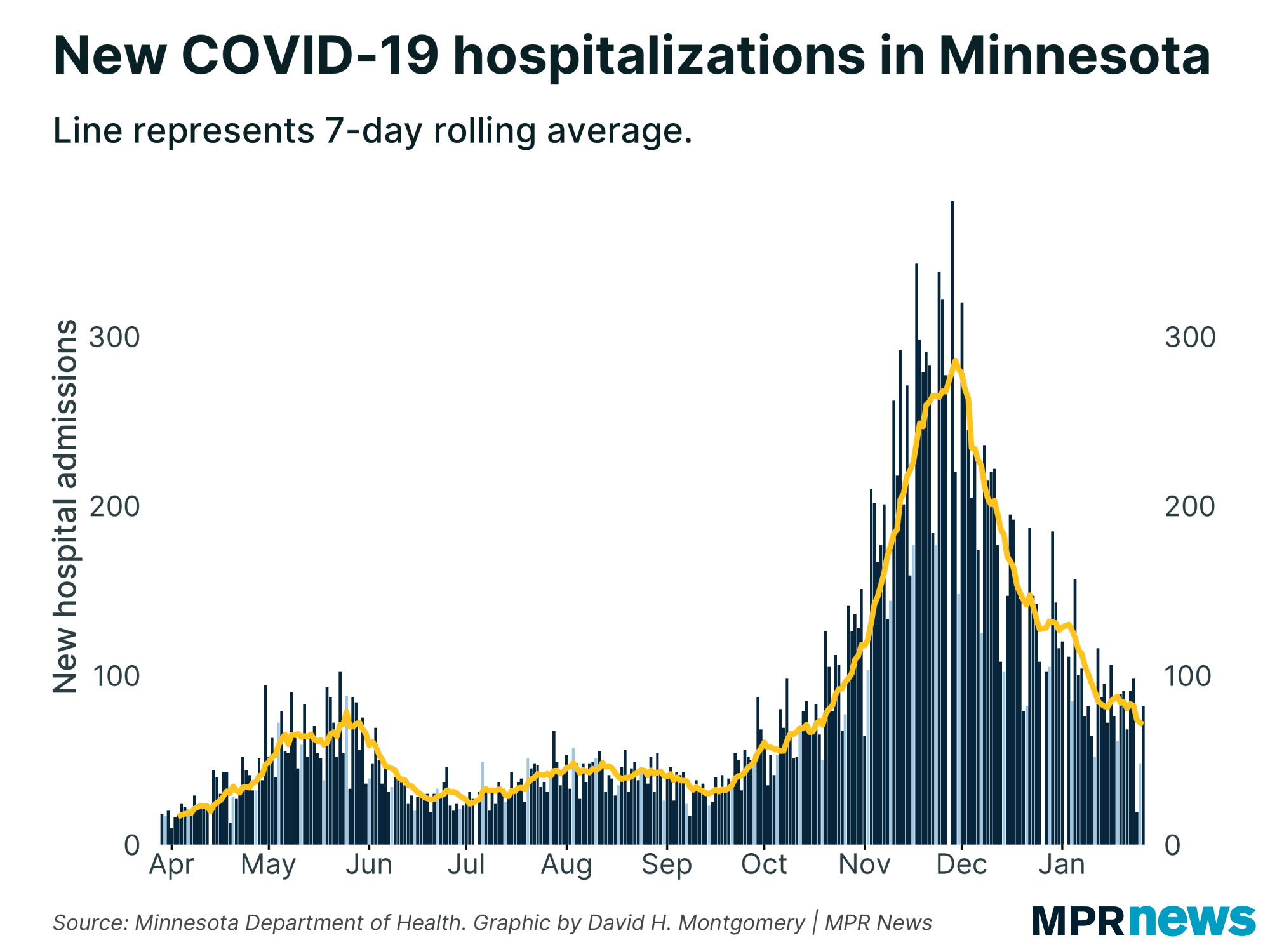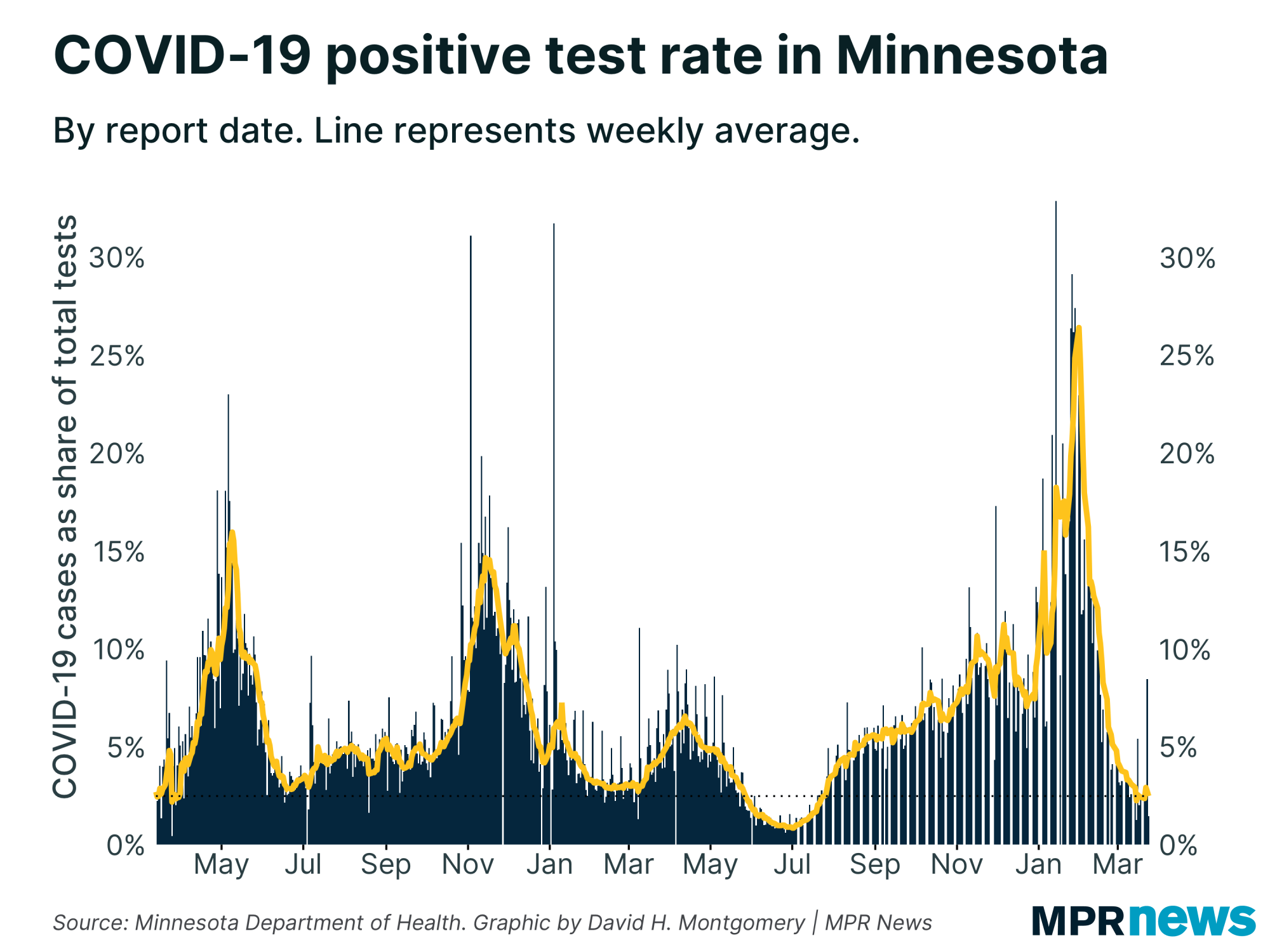Dec. 17 update on COVID-19 in MN: 83 deaths; hospitalizations, cases easing

Go Deeper.
Create an account or log in to save stories.
Like this?
Thanks for liking this story! We have added it to a list of your favorite stories.
Updated 11:40 a.m.
Minnesota officials on Thursday reported another 83 COVID-19 deaths, extending an already dreadful December — 1,065 deaths posted in the first 17 days of the month, atop more than 1,100 deaths recorded in November.

The grim numbers were offset somewhat by the fact that new daily caseloads and hospital admissions continue to retreat from their late November, early December highs.
The Health Department posted 2,775 newly confirmed or probable COVID-19 cases, a relatively moderate number. The agency reported 1,222 people remain in the hospital with COVID-19 as of Wednesday.
Of those hospitalized, 289 needed intensive care — the first time in more than a month that fewer than 300 people with COVID-19 needed an ICU bed.
Turn Up Your Support
MPR News helps you turn down the noise and build shared understanding. Turn up your support for this public resource and keep trusted journalism accessible to all.

Despite those improving metrics, officials have continued to warn that Minnesota is not out of the woods. Gov. Tim Walz on Wednesday extended the state’s ban on indoor bar and restaurant service, saying the state remained in a precarious spot and that Minnesota may even face an additional spike in February.
The Health Department’s newest tally of confirmed or probable COVID-19 cases put the pandemic total at 389,171. In about 92 percent of those cases, people have recovered to the point they no longer need to be isolated.

The deaths reported Thursday raised Minnesota’s toll to 4,658. Among those who’ve died, nearly two-thirds had been living in long-term care or assisted living facilities; most had underlying health problems.
The toll remains awful. About 2,200 COVID-19 deaths have been reported during November and December. That’s nearly half of all the deaths in the pandemic.
Caseloads spread across age groups
People in their 20s still make up the age bracket with the state’s largest number of confirmed cases — more than 74,000 since the pandemic began, including nearly 40,000 among people ages 20 to 24.

The number of high school-age children confirmed with the disease has also grown, with more than 30,000 total cases among children ages 15 to 19 since the pandemic began.
Although less likely to feel the worst effects of the disease and end up hospitalized, experts worry youth and young adults will spread it to grandparents and other vulnerable populations.
It’s especially concerning because people can have the coronavirus and spread COVID-19 when they don’t have symptoms.
New cases ebb in rural Minnesota
Central and western Minnesota drove much of the increase in new cases over the past five weeks, while Hennepin and Ramsey counties showed some of the slowest case growth in the state.

After a spike in confirmed cases through much of November and early December, all regions of the state have seen new case numbers plateau or fall.
Hot spots continue to pop up in rural counties relative to their population.

New caseloads still heaviest among people of color
In Minnesota and across the country, COVID-19 has hit communities of color disproportionately hard in both cases and deaths. That’s been especially true for Minnesotans of Hispanic descent for much of the pandemic.

Even as new case counts ease from their peak a few weeks ago, the data shows people of color continue to be hit hardest.
Distrust of the government, together with deeply rooted health and economic disparities, have hampered efforts to boost testing among communities of color, officials say, especially among unauthorized immigrants who fear their personal information may be used to deport them.
Similar trends have been seen among Minnesota’s Indigenous residents. Counts among Indigenous people jumped in October relative to population.
Officials continue to plead with Minnesotans to wear masks in public gathering spaces, socially distance, stay home if they don’t feel well and otherwise stay vigilant against the spread of COVID-19.
No sign yet of Thanksgiving celebrations surge
Officials have been anticipating another wave of climbing caseloads and hospitalizations soon originating from Thanksgiving holiday celebrations. But it hasn’t happened yet.
State public health leaders this week and last said they were somewhat hopeful that many families heeded the public pleas to not gather in big groups for Thanksgiving, and so the worst-case scenarios of a post-holiday surge might not materialize.
But they’ve also cautioned that it’s too soon to say a Thanksgiving celebration surge will not happen.

While the drops in cases and hospital admissions are encouraging, “we’re still way above what is considered a more manageable rate of growth in cases,” Health Commissioner Jan Malcolm told reporters Tuesday.
“We’re still in a volatile state, a risky state,” she added. “Rapid case growth can happen at these levels.”
Officials say they’ve been working to balance the recent improvement in conditions with the reality that the pandemic isn’t over.
They continue to urge Minnesotans to do all they can — wearing masks in public gathering spaces, socially distancing and staying home if you don’t feel well — to guard against the spread of the disease.
Walz and other officials have expressed hope that the vaccines arriving now in Minnesota and across the country will ease the strain and the need for restrictions eventually, but not yet.

Shots began going into arms in Minnesota this week, but officials caution it will take months for vaccinations to be widespread in the state.
The governor told reporters that he realizes the restrictions are painful, but said the pandemic is still threatening to overwhelm hospitals.
“It would be so much easier if none of this was happening,” he said Wednesday as he extended his current monthlong ban on indoor bar and restaurant service through the holidays, a move he described as a painful but necessary step as they state continues to struggle to stem the spread of COVID-19.
“It would be so much easier if the neighbors weren't dying,” he said, “but that's not reality.”
Developments around the state
Health care workers at St. Cloud Hospital receive COVID vaccine
CentraCare started issuing the first doses of the Pfizer-BioNTech COVID-19 vaccine to health care workers at St. Cloud Hospital on Thursday. Three health care workers at central Minnesota's largest hospital who care for patients with COVID-19 received the first doses of the vaccine.
Amy White, a registered nurse who's spent 37 years in the hospital's intensive care unit, received the first dose. White received a shot in her arm, and was cheered by fellow health care workers.
"However many years I've been doing this, we've never had any battles like this in our unit and our career, so this is a major step we're taking today,” she said.
CentraCare plans to vaccinate front-line workers St. Cloud Hospital's COVID-19 units over the next few days. The vaccine also will be distributed to smaller hospitals in central Minnesota and St. Cloud Hospital is serving as the regional hub for receiving the Pfizer vaccine, which must be stored at very cold temperatures.
— Kirsti Marohn | MPR News
Minnesota businesses plan to defy shutdown order and reopen
More than a hundred businesses statewide are planning to reopen as direct defiance of Gov. Tim Walz’s COVID-19 restrictions.
The group ReOpen Minnesota Coalition is encouraging businesses statewide to reopen as many are struggling to stay afloat during the pandemic.
The group's Darius Tiechroew said bars restaurants and gyms statewide are at risk of closing permanently under the governor's executive order and owners can’t support their families and employees. He also said the just-approved $216 million legislative aid package is only a short-term and temporary fix for a bigger problem.
"It may delay the demise of their business and their livelihoods. A week or two. But that's it," he said. "A lot of these places can't afford to wait another week or two."
— Hannah Yang | MPR News
Top headlines
Minnesota bars' licenses suspended for defying restrictions; AG Ellison sues the taverns: Attorney General Keith Ellison is seeking to enforce a closure order and penalize businesses that flouted Walz’s restrictions. They also face the loss of their liquor licenses.
Bars and restaurants fume at continued indoor dining ban; some pledge to defy order: Many restaurateurs and bar owners are worried their businesses won’t make be able to survive another three weeks of restrictions. Meanwhile, about 100 hospitality businesses have pledged to defy the governor’s order to remain closed.
Analysis: Are restaurants and bars kindling COVID-19 in Minn.? With Gov. Tim Walz using his emergency powers to close certain types of businesses and events, it's important to get a handle on which types of businesses and events are linked to COVID-19 spread. While our data here is somewhat limited, data reporter David H. Montgomery takes a deep dive into numbers behind outbreaks and their implications.
Minnesota elementary schools can reopen Jan. 18: Gov. Tim Walz is giving elementary schools across the state the green light to reopen next month if they adopt a number of strategies to contain the spread of the coronavirus. It’s a shift from previous policy, which required districts to rely on county-level data about the level of virus transmission in their communities to guide their reopening plans.
COVID-19 in Minnesota
Data in these graphs are based on the Minnesota Department of Health's cumulative totals released at 11 a.m. daily. You can find more detailed statistics on COVID-19 at the Health Department website.


